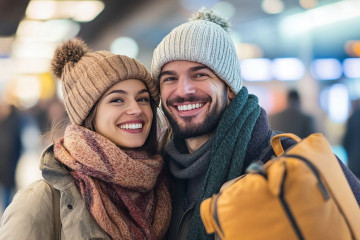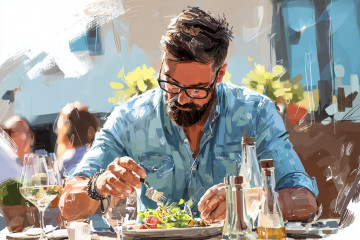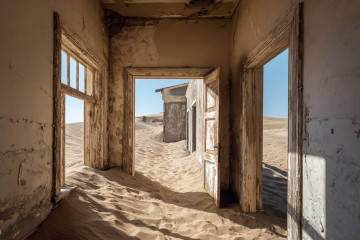Our best health tips for long-term travel as digital nomads will help you stay fit, making healthy choices about food while traveling and help you get the right amount of sleep.
Staying healthy while traveling might seem overwhelming because you’re away from all your routines at home.
For us, part of the fun challenges of exploring new places is figuring out how to stay healthy and fit.
We stay healthy while traveling with a bit of balance and conscious effort. While trying new things, we also tie in habits from home and translate them into different places. How do we stay healthy during long-term travel as digital nomads?
- We make an effort to work out.
- We shop at markets to get our fruits and vegetables.
- We cook our own food when we can.
- We make time to rest and reset.
Staying healthy while traveling didn’t always come easy, and we’re still working on our goals of working out to stay fit and eating well to maintain good health. Here are our main tips and how we achieve them.
1. Work out while you travel, from running to CrossFit to yoga.
At various points during our long-term travel together as a couple, we’ve developed and kept (and also gotten lazy with) several fitness habits. In Lima, Peru, and Medellin, Colombia, Dan was a member at the CrossFit gyms in our neighborhoods.
Dan’s biggest success was doing a strenuous workout class after a day of remote work in our workspaces. He, therefore, avoided less-healthy habits like going to happy hour or eating a big dinner out at a restaurant.
Becca also worked out during the same months, but in a different way. In Lima, she was a monthly member at local yoga studio called Lima Yoga, and in Medellin, she bought a 30-day pass for weekday morning yoga at the Medellin Selina coworking space.
Knowing that she had made an investment for a 30-day membership, she sometimes went to yoga classes as early as 6:45 am on weekdays and as early as 9 am on weekdays (rough, right?), averaging yoga classes usually four times per week!
Starting in Mexico City, after acclimating to the high altitude, we both started running on our own. Mexico City has an awesome park called Bosque de Chapultepec, which has a great running path.
The neighborhood of Condesa is nice as well for running because the traffic isn’t heavy, the sidewalks are pretty wide, and there’s a running path around Avenida Amsterdam, which forms an oval around a park.
We also ran together during mornings in Hanoi, Vietnam, where a promenade around the city’s most popular lake is an ideal place for a run (if you go early before the traffic starts and the tourists come out!).
2. Be conscious of the foods that you eat when you’re not at home.
The food is, of course, one of the best reasons to travel. In Mexico, you can get a taco for $0.40, and in Vietnam, you can eat a bowl of pho on the street for $2. We can’t enjoy these types of foods for the same prices at home in the US!
While great food might come at very affordable prices for us (compared with prices where we come from), chances are that not everything we see is healthy. We’re conscious of when, how and what we consume when we aren’t the ones cooking.
Control how often you dine out.
To this end, we try to control how often we dine out at restaurants. This is challenging, especially when entertaining friends visiting, going out to a catered event or social gathering or going to a food festival as a cultural activity.
We always try and make dinner on days when we go out for lunch. If we are home to cook lunch, we may consider having dinner out if we haven’t had a chance to get new groceries.
We’re most likely to eat out in vegetarian-friendly destinations, but for places where it’s hard to be vegan or vegetarian, we default to cooking.
Control which types of food you eat when dining out.
We also try to control the types of foods we eat when we dine out. We also try to eat healthy alternatives if we want to have a quick snack or a meal when we’re away from home.
If we’re walking around and craving a snack, we’ll opt for fruit smoothies over French fries, and unsweetened tea or coffee rather than beer or wine. This method helps us solve cravings, while not consuming excess fat or calories.
A tip for flying is to bring healthy snacks for the flight. This is so that you don’t wind up buying airplane food (cheap budget flight where they have a menu of snacks like chips and junk) or a flight with no food offerings at all, for when you have to find something to eat at the airport.
Pack some fruits and veggies from a local market in reusable containers and you’ll be so glad you did. We like the stainless steel EcoLunchbox food containers for travel, which are leak-proof, eco-friendly, reusable and plastic-free food storage solutions for trips.
3. Make the extra effort to cook meals while traveling.
We mention that we cook a lot, so we’re going to tell you how we manage this.
We filter our accommodation search with having a kitchen as a priority.
We feel most comfortable when we have a kitchen, so we put this at the top of our list when searching for Airbnb apartments, listings on Booking.com or hostels. If we have to, we contact an Airbnb host directly to ask about the components of a kitchen – is there a burner or stove? Is there a rice cooker? Are there pots and pans for cooking?
We look up the nearest market so that we can start shopping.
In Mexico, it was really hard for us to resist tacos (Becca) and tortas (Dan) for three meals a day, but we made an effort to go to the local market and pick up fresh vegetables.
While traditional produce markets were easy to find in Mexico City’s downtown, they were not so prevalent in the Condesa area, which was trendier and did not have these types of markets so accessible to us. We, therefore, had to opt for the nearest modern supermarket.
Determine if you need any extra kitchen tools.
Take inventory of the kitchen and see if there’s anything that you need. For us, in Hanoi, we had to get a cutting board and some spoons. Most of the places that we visited had a good stock of kitchen items to choose from.
Choose your cooking oils and condiments wisely.
The benefit of cooking at home is that you can control your oil, salt and sugar. We prefer to buy olive oil for health reasons, but if we’re somewhere where we can’t find it, we opt for the next-healthiest type of cooking oil.
For seasonings, we both have our own preferences. Dan prefers cooking with salt and other seasonings, and Becca prefers avoiding salt and using pepper and chili. We both like hot sauce, salsas and chili sauce, so we buy these items (in plastic bottles when possible) and take them with us to a new place if we travel by bus or train.
4. Snack on fruits and veggies and avoid things like chips, street meat or sugary junk.
In most places, from New York to Vietnam, you can find vendors who sell fruit on the street. This seems much more prevalent in warmer places, such as Central and Andean South America, and Southeast Asia, when compared with Europe.
We admin, these street snacks are good, really good. If you make a habit of grabbing a few quick snacks throughout the day, you can find yourself in an unhealthy situation!
We do keep in mind that buying fruit from the street means there may be a layer of pollution or dust on the fruit. For this reason, unless the fruit has a peel, we wait until we get home to wash fruit from the street.
Lots of cities, towns and villages have farmers markets. Look up if a local farmers market exists, or ask around.
Aside from travel costs, we tend to opt for fruit and vegetables rather than chips and things that come in packages. Eating fruits and vegetables feels better and helps digestion, and you can usually find cut-up fruit in a convenience store or grocery store if you cannot locate a street vendor selling fruits or vegetables in most countries.
Our favorite fruits from places we’ve been are the mangoes and dragonfruit in Colombia, the guavas in Mexico City and the granadinas in Peru.
5. We shop at local markets and grocery stores.
We love markets and grocery stores! It is wonderful to see how people in other countries shop, and we think this is one of the coolest things about world travel.
In Medellin, our neighborhood of El Poblado did not have a produce market, so we would shop at the local grocery store chain called Carulla. We didn’t have any complaints about this, though, as the produce section was gigantic, and we always were able to pick the freshest fruits and vegetables in huge amounts.
In Mexico, once we “moved” across town to Selina Mexico City Downtown, we found ourselves next to Mercado San Juan Arcos de Belen, where we came so often that we got to know a mother and son who sold dried fruit, nuts and fresh juice. They started to know us because we came several times per week.
6. We stay hydrated daily during travel.
Staying hydrated is key to a healthy system! Especially in hot climates, it’s crucial for our bodies to have enough liquid. This is where drinking enough water and consuming fruits and vegetables that have high water content are great!
If you tend to drink a lot of coffee and tea like we do, staying hydrated is also important to counteract caffeine levels. So, what do we do?
We always carry around water in our water bottles and we fill up whenever possible, in case we won’t see a clean water source for a while. Of course, we like to avoid buying plastic bottles (sustainable travel tips!) as much as possible, so we take around our water bottles with us all day.
7. We aim to sleep eight hours per night while traveling.
While we both need different amounts of sleep to function properly, we tend to average on eight hours, which is a healthy and recommended number of hours to sleep. A few things help us sleep this proper amount.
Having blackout shades or curtains
If you luck out with a hostel room, hotel room or apartment rental with blackout shades, congratulations! You will probably be sleeping through the night.
If you like being woken up by the sun, it’s sometimes smart to check what time the sun will rise. Cities around the world will have varying sunrise times during different seasons. You can calculate how this will affect you!
A sleeping mask
Becca uses a sleep mask if she’s trying to sleep in a room that lacks curtains, or on a plane, train or bus.
The sleep mask came in the most handy in Estonia, where we traveled during the ‘longest day of the year.’ The sun would come up around 3:30 or 4:00 am, and our room would get leaks of light well before we wanted to be up. Becca used a sleep mask every night to drain out the light and to sleep until she wanted to.
Earplugs
We bonded over the need for earplugs early on when talking about travel. Becca is a lighter sleeper than Dan is, so we handle noise differently. We both sometimes need earplugs if we’re in a hostel or any type of property that has noise coming from above, below or outside.
The most challenging noise we’ve dealt with recently was in Mexico City, where we lived in a first-floor apartment. In addition to overnight construction and street repaving, some types of vendors would start rolling through the streets around sunrise. The noise was pretty loud! Ear plugs help drown this type of unwanted distraction out.
8. Aim to make time to relax and reset while traveling and working remotely.
Not having an office environment all the time can make working any time of day a reality. Especially in Asia with the shifted time zones, we find ourselves working on things in the morning, in the afternoon again, and then at night when our colleagues and clients come online in the US.
In order to make time for ourselves, we block out time for activities like sightseeing, meeting with friends, cooking and resting. This is almost harder than it seems, but because our laptops are our offices, we can get dragged into all types of work the minute we connect to WiFi.
Our favorite ways to make time for ourselves outside of work are going for runs, going on photo adventures to new places, sitting down for a new type of food and cooking for each other.



2 Comments
how can i get synthroid cheap
hq pharmacy online 365